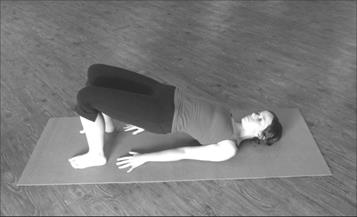
Asanas (Postures) for Late Summer
The main aim with the late summer asana practices is to open the stomach and spleen channels on the front of the body, while strengthening and toning the muscles around the spine on the back of the body. Cultivating power and strength in the legs also helps to ground the system’s energy into the earth. The following pages explore some asanas that achieve this aim.
Incorporate these postures into your asana practice during late summer to stimulate the stomach and spleen.

Bridge – Setu Bandha Sarvangasana
Main benefit – Strengthens the back muscles and opens the front of the body.
1. Lie on your back on the mat, arms along the side of the body, palms down.
2. Bend your knees, place your feet on the mat close to your buttocks, feet hip width apart.
3. As you inhale, flatten your back into the mat and as you exhale, slowly peel your hips from the floor and push them towards the sky.
4. When you reach the top, suck your belly in, look down the midline of your body with your head still on the floor. Work the arms and hands gently into the floor and gently squeeze the knees towards each other. The knees do not need to touch; the inner thighs just need to be activated.
5. Find your breath and hold for at least three long breaths.
6. When you are ready, inhale to raise a little higher, then, as you exhale, start to slowly peel your spine back onto the mat. Rest.
7. Repeat this action 2-3 times.
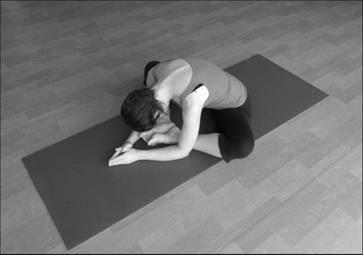
Butterfly – Buddha Konasana
Main benefit – Opens the inner legs and opens the back of the body.
1. Sitting on the floor or on some folded blankets, bring the soles of your feet together. Give yourself some space between your groin and your feet.
2. Grabbing hold of your feet, inhale to lengthen the spine; exhale to draw your heart space down toward your feet and the floor.
3. Allow yourself to move into this pose slowly. While deep in the pose, really focus on relaxing your legs and knees toward the floor. Relax your back and draw your head toward the floor, relaxing the back of your neck and shoulder. Close your eyes and breathe here for a few minutes.
4. When you’re ready to come up, simply roll up slowly back into a sitting position with your back straight.

Locust - Salabhasana
Main benefit – Strengthens the back of the body which includes the neck extensors.
1. Lie on your belly in the middle of your mat.
2. Bring the arms down the side of the body, palms facing up. Feet hip width apart. Looking forward, resting the head on the chin.
3. On an inhale, start to raise the upper body, the arms and hands off the floor. Try to get the arms parallel with the floor.
4. Then start to raise the legs off the floor. Try to keep your legs straight.
5. Look diagonally down towards the floor to keep the neck in line with the spine.
6. Now gently squeeze the hands towards each other so you activate the muscles around the shoulder blades.
8. Keep the breath moving. Hold for 3-4 breaths and then slowly release and relax back onto your mat.
9. Have a little rest for a few moments and do it at least one more time.
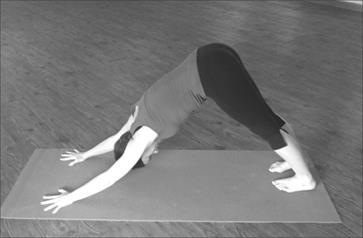
Down Facing Dog – Adho Mukha Svanasana
Main benefit – Strengthens arms, shoulders and opens the back of the legs.
1. Come onto all fours with hands underneath the shoulders and knees under the hips. Spread your fingers wide.
2. Tuck the toes under, start to extend the arms and start bringing the knees off the floor
3. Come to extend the arms and start to work the legs straight. Try to bring the weight back into your legs and not so much into your arms.
4. Look to the floor just under your belly button.

Low Lunge – Anjaneyasana
Main benefit – Opens the psoas muscle, the front of the body, and strengthens the back.
1. Ideally, you will start in a standing-forward, bent position (Uttanasana) at the front of the mat. Then simply step your left leg to the back of the mat and bring your back knee to the floor; the top of your back foot should be flat on the floor.
2. Make sure your front ankle is either just in front of or directly underneath your front knee.
3. Open your heart up and bring your arms out to the side, and then bring them up above your head. In this picture, the hands are shoulder width apart—this makes it easier to relax the shoulders down away from the ears. You can bring your hands together too, if that feels more natural.
4. Allow your lower back to lengthen and gently work your hips forward and down toward the floor, opening the front of your left hip.
5. After a few breaths, bring your torso and your arms down toward the floor, tuck your back toe under and step to the front of the mat, returning to your forward bend at the front of the mat.
6. Repeat on the other side.
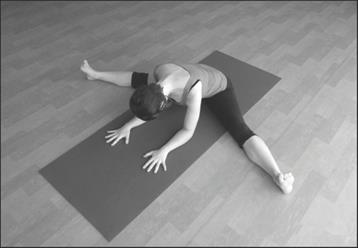
Wide Legged Seated Forward Bend – Upavistha Konasana
Main benefit – Opens the inside of the legs
1. Start by sitting on the floor or upon some folded blankets (recommend the folded blankets for this one).
2. Bring your legs out wide—to about 90% of your capacity.
3. Start by bringing your hands onto the floor behind your back. Inhale to lengthen your spine and draw your toes back; exhale to use your arms to draw your torso forward and down.
4. If you are new to this stretch then it is probably best to keep your hands behind your back to help you out. If you are more flexible, then bring your hands out in front of your body and use them to help you forward and down.
5. Take your time with this one. Use your breath to support you. You can experiment a little with this one by moving your torso slightly to the left or right to get a different kind of stretch in your inner legs. Stay as long as you like.
6. When ready to come out, simply draw yourself up back into a seated position and slowly draw your legs together.

Standing Back Bend
Main Benefit –Strengthens the back of body and opens the front.
1. Place your hands, onto the lower back with finger pointing downwards.
2. Draw the elbows towards each other; suck the belly in before gently drifting the hips forward and leaning back.
3. Feel the heart and throat open. Only hold for a breath and then come out.
4. Come out by drawing your torso forward and releasing the arms. Feel free to move the hips around in circles to release and then try again.

Horse Stance
Main benefit – Strengthens and grounds the legs into the earth.
1. Stand in the centre of your mat
2. Bring your legs wide apart (about 1 leg’s length apart)
3. Bring your hands into prayer position; relax the shoulders, arms are light.
4. Start to gently squat into your legs, keep the knees working back so you’re working the hips open.
5. Once you find a spot where you feel “switched on” and activated through the legs, hold it for some time.
6. Connect with your breath. Gently squeeze Mula Bundha (gentle squeeze of the anus muscle) and hold the posture.
7. Hold for at least 10 long steady breaths before slowly easing up and coming out of it.
8. Be sure to practice this a few times in each session. It’s a great practice to do if you feel too “heady”.

Reverse Table Top – Ardha Purvottanasana
Main Benefit – Strengthens the back of the body and opens the front.
1. Come to sit on your mat, with your knees bent and feet flat on the mat.
2. Bring your hands just behind you, fingers pointing forwards.
3. Start by raising the buttocks just off the floor.
4. If ok, raise the hips all the way so they are in line with your knees and shoulders.
5. Let your head rest back into the fold of the neck.
6. Get a sense of the shoulder working down away from the head. Allow the elbows to have a tiny bend in them, avoid hyperextending the elbow joint.
7. Plant your fingers and toes into the floor.
8. Connect with your breath and hold for around 5 long steady breaths.
9. To come out slowly, lower your buttocks first; the head will naturally roll up without any effort.
10. Come to sit back on the mat.
Other techniques that stimulate the Stomach and Spleen:
Singing
Have you heard that singing is good for digestion? According to Oriental medicine, singing stimulates Qi and blood while also calming the mind. Therefore, activities like going out to karaoke after dinner or even singing in the shower are a recommended practice, especially in late summer.
Massage the Legs
1. Sit either on the floor or on a comfortable chair and start to gently squeeze the inside of one of your lower legs. Work up from the ankle to the knee. The inside of the leg contains the spleen, kidney and liver channels. The inside of the leg is considered to be yin and triggers a relaxed and sometimes sleepy state.
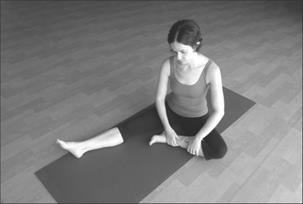
2. After you have worked on the inside of the legs, move your attention to the outside of the legs. Bend one knee up and start to pummel (loose fist thumping) the outside of the lower leg. Work up from above the ankle to around the knee. After a good pummeling, use your palm and thumb to squeeze the muscles on the outside of the leg. The outside of the leg contains the stomach and gallbladder channels and is considered to be more stimulating and energizing due to it being a yang part of the body.
Mindful Eating and Prayers for Eating
Practicing mindful eating can be one of the most powerful practices to nourish and support the stomach and spleen while also training the mind. Mindful eating involves eating slowly, with full awareness and without distraction. Also, including a little prayer, as a way to give thanks to Mother Earth and as a way to purify the food, is an age-old practice that many spiritual and religious traditions still practice. The following example of a mindfulness food prayer comes from Buddhist monk Thich Nhat Hanh, from his book Savor: Mindful Eating, Mindful Life.
The Five Contemplations
1. This food is the gift of the whole universe: The earth, the sky, numerous living beings and much hard, loving work.
2. May we eat with mindfulness and gratitude so as to be worthy to receive it.
3. May we recognize and transform our unwholesome mental formations,
especially our greed, and learn to eat with moderation.
4. May we keep our compassion alive by eating in such a way that we reduce the suffering of living beings, preserve our planet and reverse the process of global warming.
5. We accept this food so that we may nurture our sisterhood and brotherhood, strengthen our community, and nourish our ideal of serving all living beings.